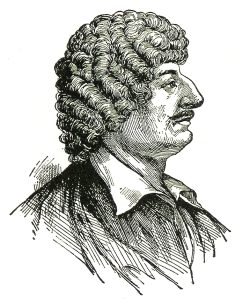40 “To the Virgins, to Make Much of Time” (1648)
With an Introduction by R. Callaghan
Robert Herrick
Introduction

Robert Herrick, baptized on August 24, 1591, was the seventh child (fifth surviving) and fourth son of Nicholas, a London goldsmith, and Julian, and was named after his uncle. When Herrick was only fourteen months old, his father allegedly committed suicide by jumping out of a window and falling to his death (Cain). As Herrick grew older, he began writing poetry and is well known for his lyrical style of writing and his interpretation of “carpe diem” in his poetry. Herrick eventually wrote the poem, “To the reverend shade of his religious Father,” in which he resurrects his father by eternizing him in poetry. Other well-known poems of his include “To the Virgins, to Make Much of Time,” “Upon Julia’s Clothes,” and “Corinna’s going a Maying,” all of which can be found in the book Hesperides: or The Works both Humane & Divine of Robert Herrick Esq, published in 1648.In his lifetime, Herrick was referred to as a “Cavalier Poet,” which was a “school of English poets in the seventeenth century” (“Cavalier poet”). His classification as a Cavalier Poet was due to his political beliefs and his loyalty to the King during the English Civil Wars of the seventeenth century. He was forced into exile during that time due to his loyalist beliefs and was even stripped of his vicarage in Dean Prior, though he later returned there and remained until his death in 1674 at the age of 83. However, his exile is worth noting because it was in this exile that he finished Hesperides.
“To the Virgins, to Make Much of Time” Text
Gather ye rose-buds while ye may,
Old Time is still a-flying;
And this same flower that smiles today
Tomorrow will be dying[1].
The glorious lamp of heaven, the sun,
The higher he’s a-getting,
The sooner will his race be run,
And nearer he’s to setting.
That age is best which is the first,
When youth and blood are warmer;
But being spent, the worse, and worst
Times still succeed the former.
Then be not coy, but use your time,
And while ye may, go marry;
For having lost but once your prime,
You may forever tarry[2].
Sources:
“To the Virgins, to Make Much of Time” [PDF] edited by Bonnie J. Robinson, Ph.D. and Laura J. Getty, Ph.D. from British Literature: Middle Ages to the Eighteenth Century and Neoclassicism [PDF] is licensed by CC BY-SA.
Cain, Tom. “Herrick, Robert.” Oxford Dictionary of National Biography, 3 Jan. 2008, https://doi-org.ezaccess.libraries.psu.edu/10.1093/ref:odnb/13092. Accessed 10 Sept. 2024.
“carpe diem, n.” Oxford English Dictionary, OUP, July 2023, https://doi.org/10.1093/OED/8114727761.
“Cavalier poet.” Wikipedia, Wikimedia Foundation, Inc, 21 Sept. 2023. en.wikipedia.org/wiki/Cavalier_poet. Accessed 13 Dec. 2023.
Gilead, Sarah. “Ungathering ‘Gather Ye Rosebuds’: Herrick’s Misreading of Carpe Diem.” Criticism, vol. 27, no. 2, 1985, pp. 133–53. JSTOR, jstor.org/stable/23110526. Accessed 13 Dec. 2023.
“Robert Herrick.” Poetry Foundation, poetryfoundation.org/poets/robert-herrick. Accessed 13 Dec. 2023.
“tarry, v.”. Oxford English Dictionary, OUP, July 2023, https://doi.org/10.1093/OED/4589433746.
Cite this Chapter:
Callaghan, R. Introduction to Robert Herrick’s “To the Virgins, to Make Much of Time.” Transatlantic Literature and Premodern Worlds, edited by Marissa Nicosia, et al., Pressbooks, 2025, psu.pb.unizin.org/opentransatlanticlit/chapter/to-the-virgins-to-make-much-of-time/.
Herrick, Robert. “To the Virgins, to Make Much of Time.” Transatlantic Literature and Premodern Worlds, edited by Marissa Nicosia, et al., Pressbooks, 2025, psu.pb.unizin.org/opentransatlanticlit/chapter/to-the-virgins-to-make-much-of-time/.
- Carpe Diem means “seize the day” in Latin, or in other words, “live each day as if it’s your last.” Herrick used this message frequently in his poetry to encourage the youth of his time to go out and enjoy their lives by experiencing love and adventure, in part by not wasting any of their time as young people. “To the Virgins, To Make Much of Time” is one such poem in which he discusses the ideals of a “carpe diem” mindset. In this work, Herrick discusses the passage of time and describes how people, like rosebuds, come and go. He notes that it is not possible to hold on to the past, but it is always possible to carry the memories of others as one goes forward through life. In an article by Sarah Gilead, she proposes that Herrick’s understanding of “carpe diem” is misread and inaccurate. Further, she compares “To the Virgins, to Make Much of Time” to Andrew Marvell’s “To His Coy Mistress” and shows how they both reference “sexual laziness” and the “urgency” of taking a young woman’s virginity. In this fist verse, Herrick talks of gathering rosebuds in a way that is meant to describe gathering friendships and connections with others over one’s lifetime. And in the lines, “And this same flower that smiles today / Tomorrow will be dying,” Herrick is trying to tell the reader that they will meet new people as they grow older and many of them will come and go. Not everything is permanent; time moves forward and so must the reader, as described by the line of “Old Time is still a-flying.” Herrick shows us that whether we like it or not, we cannot dwell on the past and stay trapped forever in the memories of that time, nor should we force the future to come too quickly because we do not know what tomorrow holds. We simply must seize the day ↵
- In the last verse, Herrick is trying to tell his readers to use their time wisely, to go forward with their lives and be happy with what they have accomplished. According to the Oxford English Dictionary, the term “tarry” is defined as “to delay or be tardy in beginning or doing anything, especially in coming or going; to wait before doing something; to linger, loiter.” Herrick uses this term to express this message: Don’t delay your life experiences because you’re afraid to live. Life only gets harder as you get older. Time speeds up as you start to slow down, so do everything you can before your days feel shorter and start to feel numbered. ↵

